Bath Abbey, Roman Baths & The Cotswolds
Day Three of our trip proved to be a long day, and we couldn't avoid the rain, which was pretty heavy for most of the afternoon and evening. The morning in Bath, however, was great. Enjoy these pictures.
 Here is the west entrance to Bath Abbey. The abbey and the Roman Baths share the same town square.
Here is the west entrance to Bath Abbey. The abbey and the Roman Baths share the same town square.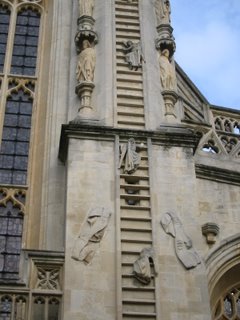 If you look closely at the façade of the abbey, you will notice a file of these angels on either side of the main doors. They are climbing a ladder to heaven!
If you look closely at the façade of the abbey, you will notice a file of these angels on either side of the main doors. They are climbing a ladder to heaven! Here is a view of the north side of the abbey.
Here is a view of the north side of the abbey. Here is the nave of Bath Abbey.
Here is the nave of Bath Abbey. The East Window, pictured here, is above the High Altar. The window depicts 56 scenes from the life of Jesus.
The East Window, pictured here, is above the High Altar. The window depicts 56 scenes from the life of Jesus.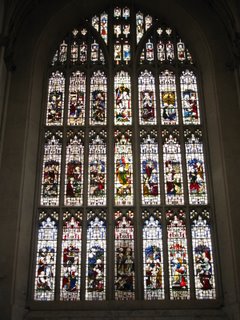 This is the West Window, situated above the main doors to the Abbey. It shows Old Testament scenes and characters.
This is the West Window, situated above the main doors to the Abbey. It shows Old Testament scenes and characters. Here is the Chantry Chapel of William Birde. He was prior during much of the construction of the abbey and died in 1525 after most of the abbey was built.
Here is the Chantry Chapel of William Birde. He was prior during much of the construction of the abbey and died in 1525 after most of the abbey was built. This is called the Gethsemane Chapel. We loved the altar cloth here.
This is called the Gethsemane Chapel. We loved the altar cloth here.  This stained glass window, depicting angels, is in the south transept of the abbey.
This stained glass window, depicting angels, is in the south transept of the abbey.After seeing the Abbey, we walked next door to the Roman Baths. The museum's audio tour was great!
 This building housed the King's and Queen's Baths.
This building housed the King's and Queen's Baths. Here is the façade of the Roman Baths. The Abbey is off to the left of this picture. From the outside, the baths don't look like anything special. The inside, however, shows otherwise.
Here is the façade of the Roman Baths. The Abbey is off to the left of this picture. From the outside, the baths don't look like anything special. The inside, however, shows otherwise. The Pump Room, shown here, lies immediately to the right of the Roman Baths. It is now a restaurant, but an original pump (fountain-like) still works, serving water from the spa below.
The Pump Room, shown here, lies immediately to the right of the Roman Baths. It is now a restaurant, but an original pump (fountain-like) still works, serving water from the spa below. The Gorgon's Head, pictured here, was part of the original Roman temple pediment. He resembles many other water gods.
The Gorgon's Head, pictured here, was part of the original Roman temple pediment. He resembles many other water gods. This is the Sacred Spring, or the King's Bath.
This is the Sacred Spring, or the King's Bath. Here is another view of the Sacred Springs.
Here is another view of the Sacred Springs. If you look very closely at the center of the picture, you should be able to make out bubbles percolating up from the water in the Sacred Spring. This particular bath has been in continuous use for 2,000 years. The bubbles are not due to the temperature of the water (which is only about 80 degrees), but rather to escaping gasses.
If you look very closely at the center of the picture, you should be able to make out bubbles percolating up from the water in the Sacred Spring. This particular bath has been in continuous use for 2,000 years. The bubbles are not due to the temperature of the water (which is only about 80 degrees), but rather to escaping gasses. Here is a bronze bust of the goddess Sulis Minerva. The Sacred Spring is associated with her. Sula was a Celtic goddess renowned for healing and wisdom. The Romans figured that Sula was actually their goddess Minerva, hence the combination of names.
Here is a bronze bust of the goddess Sulis Minerva. The Sacred Spring is associated with her. Sula was a Celtic goddess renowned for healing and wisdom. The Romans figured that Sula was actually their goddess Minerva, hence the combination of names.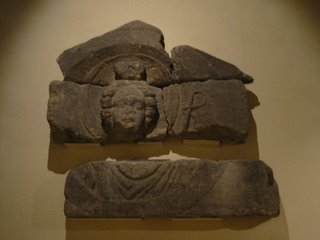 This piece of pediment shows an image of the moon goddess Luna. If you look closely, you can see her holding a whip with which she steers her chariot across the sky.
This piece of pediment shows an image of the moon goddess Luna. If you look closely, you can see her holding a whip with which she steers her chariot across the sky. Besides statues and pediments, the museum also contained many ancient mosaics, like this one from the 4th century.
Besides statues and pediments, the museum also contained many ancient mosaics, like this one from the 4th century. This ancient drain is still functioning today, carrying the overflow of the bath waters down to the Avon.
This ancient drain is still functioning today, carrying the overflow of the bath waters down to the Avon. Here is what the Sacred Spring overflow looks like. It leads to the drain, pictured above.
Here is what the Sacred Spring overflow looks like. It leads to the drain, pictured above. The Great Bath, pictured here, is the largest of the baths. When it was in use by the Romans, the bath was covered by a high barrel vaulted roof and the waters were clear. Today, exposed to the sun, the bath waters are green with algae.
The Great Bath, pictured here, is the largest of the baths. When it was in use by the Romans, the bath was covered by a high barrel vaulted roof and the waters were clear. Today, exposed to the sun, the bath waters are green with algae. Here is another picture of the Great Bath. It's too bad we weren't permitted to touch the water. However, you could see the steam rising from it. The floor and lining of the Great Bath is still the original.
Here is another picture of the Great Bath. It's too bad we weren't permitted to touch the water. However, you could see the steam rising from it. The floor and lining of the Great Bath is still the original.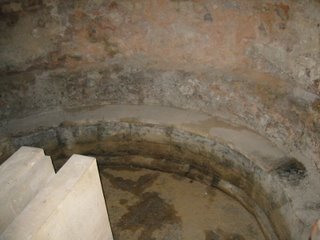 This pool in the eastern section of the baths was known as the 'healing bath.' People would travel long distances to bring their ill relatives to sit in this bath, hoping for a cure (not only physical but spiritual as well).
This pool in the eastern section of the baths was known as the 'healing bath.' People would travel long distances to bring their ill relatives to sit in this bath, hoping for a cure (not only physical but spiritual as well). The Circular Bath, shown here, is a cold-water bath, used at the end of the bathing ritual to rinse off and close the pores of the skin.
The Circular Bath, shown here, is a cold-water bath, used at the end of the bathing ritual to rinse off and close the pores of the skin.Well, our tour of Bath was now complete, so we headed north into the Cotswolds.
 Here is a view from the little village of Box (yes, that's its real name). The views from atop these hills were gorgeous.
Here is a view from the little village of Box (yes, that's its real name). The views from atop these hills were gorgeous. On our way, we found a sign to Malmesbury Abbey and decided to stop and see what it was. Here you can see the abbey on top of the hill with the River Avon below. The abbey was built in the 7th century as a Benedictine Monastery.
On our way, we found a sign to Malmesbury Abbey and decided to stop and see what it was. Here you can see the abbey on top of the hill with the River Avon below. The abbey was built in the 7th century as a Benedictine Monastery.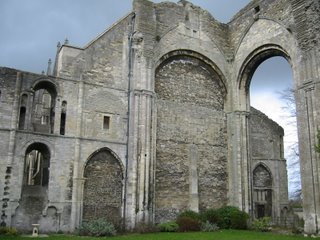 Look at the arches to the original doors. The present parish church (just behid these walls) is now only one third the size of the original abbey church!
Look at the arches to the original doors. The present parish church (just behid these walls) is now only one third the size of the original abbey church! Here is a beautiful picture of the side of the abbey.
Here is a beautiful picture of the side of the abbey. The Porch entrance to the abbey was beautiful as well, where the door is graced with three concentric arches showing carvings of: the Creation of Man, other Old Testament scenes, and the Life of Christ.
The Porch entrance to the abbey was beautiful as well, where the door is graced with three concentric arches showing carvings of: the Creation of Man, other Old Testament scenes, and the Life of Christ.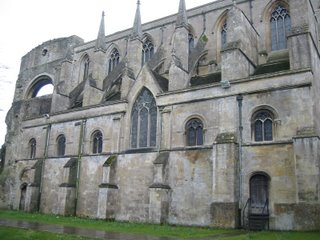 This picture of the abbey was taken from the north side.
This picture of the abbey was taken from the north side. There were school children putting on a passion play inside the abbey so we decided not to take a self-guided tour during the performance. Instead we went up a flight of stairs near the entrance to a library that housed an exhibition of four huge manuscript bibles from the 15th century (no photos allowed, unfortunately). Here is a picture of the inside of the church taken from near the main doors.
There were school children putting on a passion play inside the abbey so we decided not to take a self-guided tour during the performance. Instead we went up a flight of stairs near the entrance to a library that housed an exhibition of four huge manuscript bibles from the 15th century (no photos allowed, unfortunately). Here is a picture of the inside of the church taken from near the main doors. As you walk down the steps (or up them on your way to the abbey) you pass beautiful gardens along the River Avon.
As you walk down the steps (or up them on your way to the abbey) you pass beautiful gardens along the River Avon.Our next stop was at a town called Cirencester, the 'Capital of the Cotswolds.' Almost 2,000 years ago, when the Romans held sway in Britain, it was second to London in size and importance. It was one of the most prosperous parts of Roman Britain.
 St. John the Baptist Church lies at one end of the Market Place.
St. John the Baptist Church lies at one end of the Market Place.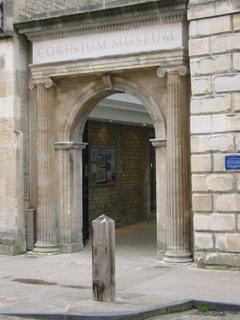 We made our way to the Corinium Museum to learn about Roman times here.
We made our way to the Corinium Museum to learn about Roman times here. The museum's greatest treasures were ancient mosaics (many from the 4th century). This is one of a series of mosaics depicting the seasons -- Fall.
The museum's greatest treasures were ancient mosaics (many from the 4th century). This is one of a series of mosaics depicting the seasons -- Fall. Here is the mosaic of Summer.
Here is the mosaic of Summer.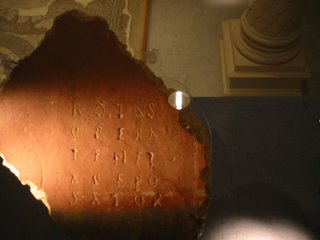 This Roman 5x5 word square was really cool, too. You can easily read the words ROTAS, OPERA, TENET, AREPO, SATOR. It reads the same across as down, and makes sense when read right to left and upwards, too. It forms a Latin sentence that translates as "The sower, Arepo, guides the wheels with care.” It is also said that it hid an anagram of the words PATERNOSTER in the form of a cross with two extra As and Os that were tacked on at the ends of the cross to represent the Alpha and Omega for Christ.
This Roman 5x5 word square was really cool, too. You can easily read the words ROTAS, OPERA, TENET, AREPO, SATOR. It reads the same across as down, and makes sense when read right to left and upwards, too. It forms a Latin sentence that translates as "The sower, Arepo, guides the wheels with care.” It is also said that it hid an anagram of the words PATERNOSTER in the form of a cross with two extra As and Os that were tacked on at the ends of the cross to represent the Alpha and Omega for Christ. This is a carving of three Celtic mother goddesses who were revered in these parts.
This is a carving of three Celtic mother goddesses who were revered in these parts. The hedge shown here is unbelievably tall! We hear that behind the hedge is a very boring house.
The hedge shown here is unbelievably tall! We hear that behind the hedge is a very boring house.The rain really started to fall during our Cirencester tour, so we decided to head back home to Cambridge through the Midlands.
 This tiny quaint village is called Bibury.
This tiny quaint village is called Bibury.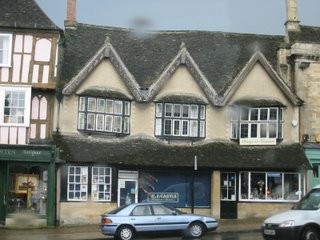 We passed the village of Burford on our way. It's too bad the weather was so bad. It looked like a very picturesque town.
We passed the village of Burford on our way. It's too bad the weather was so bad. It looked like a very picturesque town.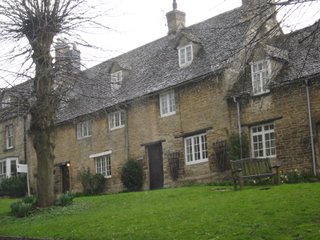 Here's another picture of houses in Burford.
Here's another picture of houses in Burford. We saw an almost complete rainbow during our drive home.
We saw an almost complete rainbow during our drive home. Debbie did a wonderful job driving on unfamiliar roads, in a rental car, at night, under driving rain, on the left! We arrived safely back in Cambridge late Thursday night, tired but pleased by a great road trip!

1 Comments:
Absolutely fantastic photos as ever! I wish I travelled with you guys!!
Post a Comment
<< Home